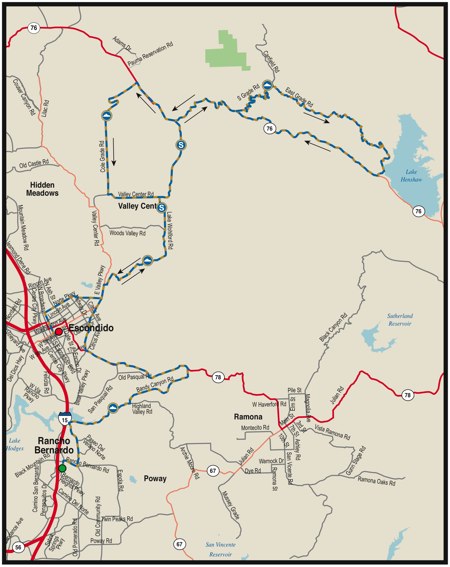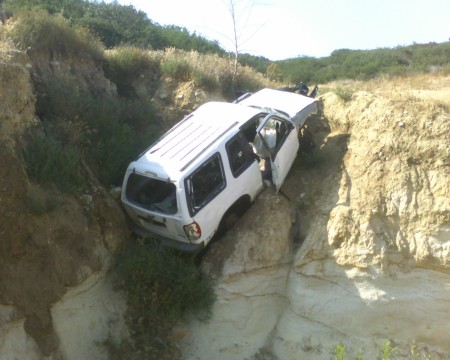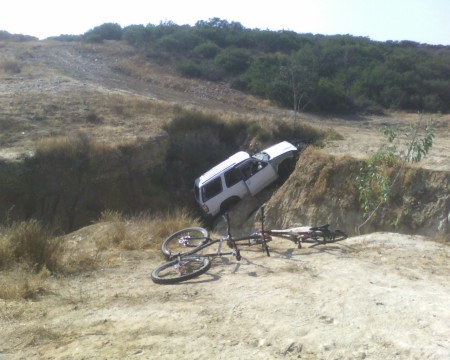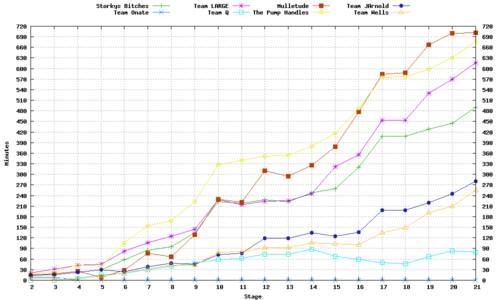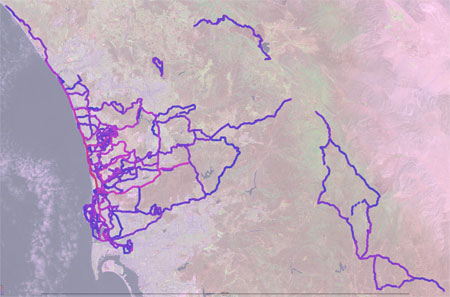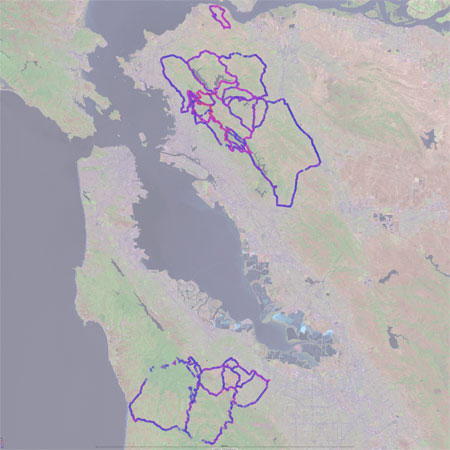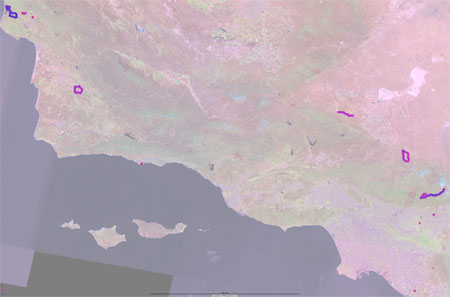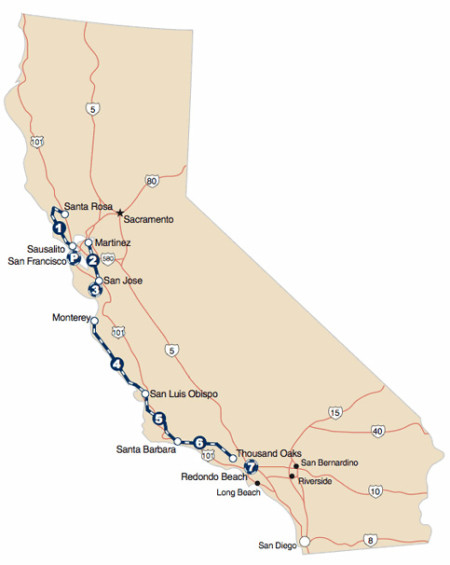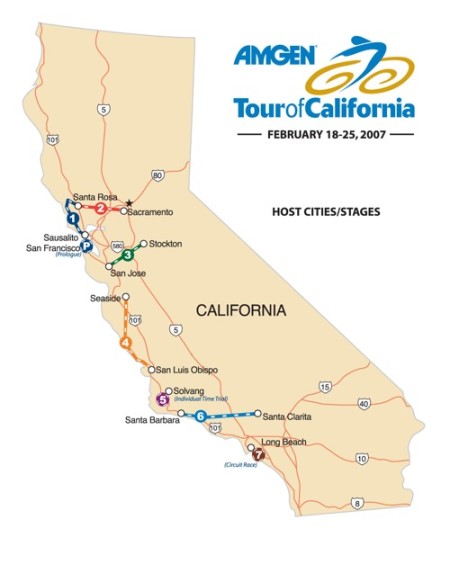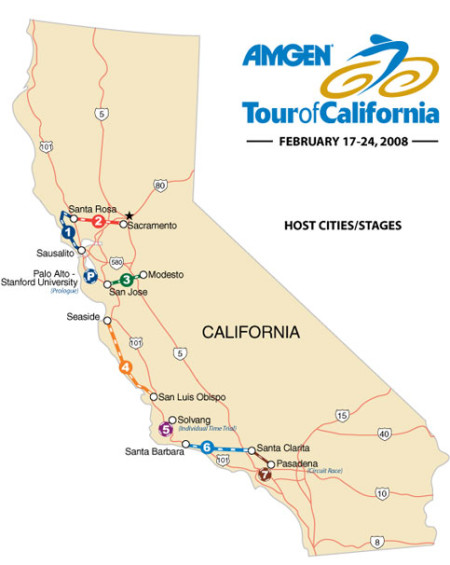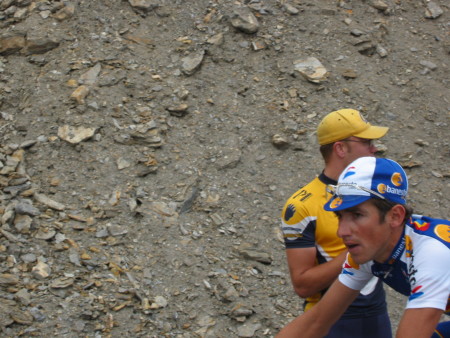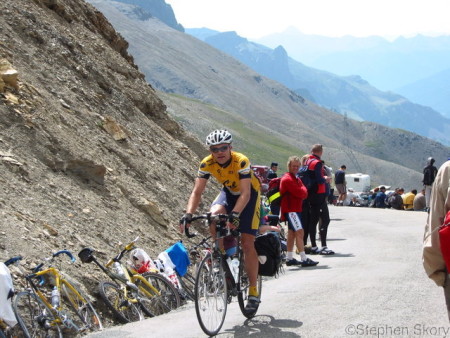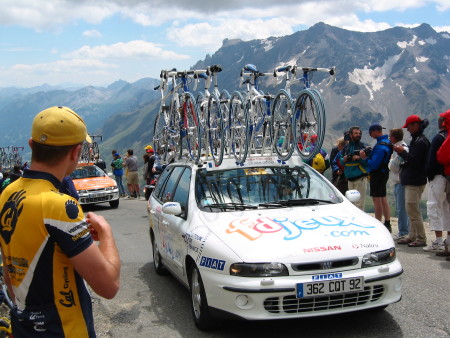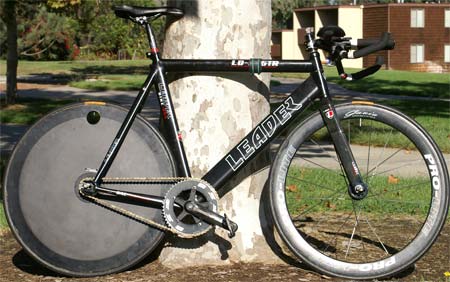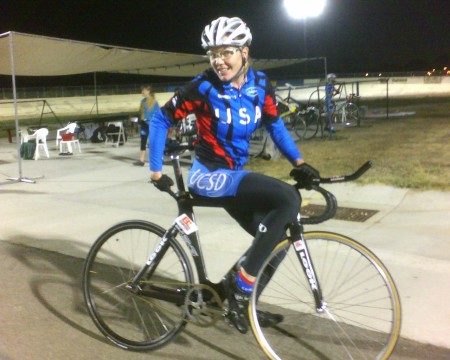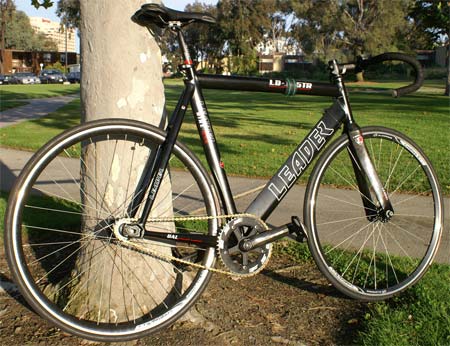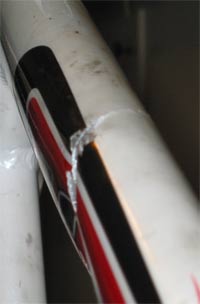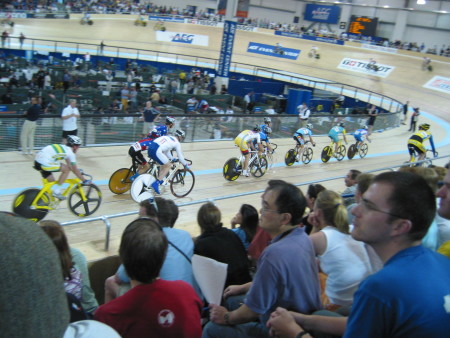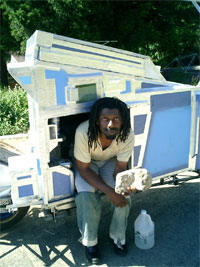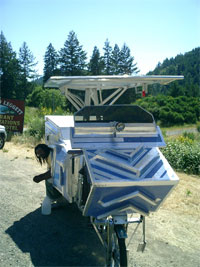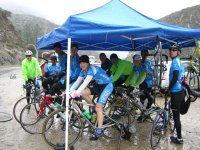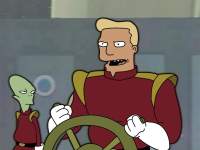Tour of California Disappointment
Below is the map showing the just-released 2009 Tour of California stage 8 route. And I'm disappointed. I thought the stage would end on the top of Palomar Mountain, but it is simply going to pass over the top, circle back around and finish in relatively boring Escondito.
Just like when the race goes through the Bay Area, I am familiar with much of this route. The race starts in Rancho Bernardo, and heads east on Highland Valley Road. That road has several nicely steep sections that kick my non-professional racer butt. I'm sure that the pros won't charge up those hills so early in the race, but their pace would drop me, no doubt.
They go up the hard side of Palomar which is a world-class climb. It is every bit as hard as the Tour de France cols I've climbed. In February the top of Palomar can be quite cold (sometimes it even snows) so the temperature changes along the route could have an effect on the race.
I wish the race organizers would have given us the grand spectacle of a mountain-top finish. I am grateful, however, that they've finally dipped below the Los Angeles divide.
Oh, and I can't forget to note: parts of the race go through Indian reservations, so the racers can get their gamblin' on, if they feel like it.
more ...Car Pit
Today Steve Lynch and I did some exploring off Peñasquitos Park and came across these derelict cars dropped into a small gorge. A VW Beetle, Audi and Ford Explorer (high gas prices, you know) were ones I could identify. There were two others rusted beyond recognition. It looked like after the cars had been shoved into the pit, they had been sledgehammered, to make sure they were really dead, of course. The Beetle was missing its motor, among other things, while the Ford didn't have any seats in it. The Audi was probably a nice car once upon a time, it had a sun roof (or moon depending on trademarks).
I like to imagine this is what might happen if the world order collapses. People just junking once useful and valuable things when you can no longer get gasoline or electricity. Kind of like Mexico.
more ...Tour de France Fantasy Pool
For the last few years I've participated in a friendly Tour de France fantasy pool with some friends. We get together, have a barbecue, and pick teams of riders. It's very much like fantasy football or baseball teams. Each team pays $20 to enter, which goes to the winner (naturally). However, the winner is obliged to use that money for a party after the Tour, so everyone wins in the end.
Some years ago an Excel spreadsheet was written to help calculate the scores. It's kind of clumsy and surprisingly un-automated. So I threw together a Python script in an afternoon which is much more automated and puts the results on the web for easy viewing.
Above is the graph of how each team is doing as a function of stage. Along with three friends I formed two teams, "Storky's Bitches" and "The Pump Handles." Neither names were my first choice; I blame Kris Wells. I've never done very well at the Tour Pool, and it's looking like this year will be no different. Of course, it's early, so things may change.
Take a look at the full results page, and check back each day throughout the Tour to see how things are progressing.
more ...Ride History Mashup
Below are some mashups showing the frequency density of where I have ridden my bikes in the last three years. (I never use my GPS on the track, so velodrome riding is not represented here. And besides, that isn't very interesting.) The circles on the maps represent a place I have passed through, and the color how many times. Red means many, perhaps as many as 5000 times for the area near my apartment, and blue means few, as few as once. That 5000 doesn't mean I've done 5000 rides, it means that there are 5000 GPS waypoints in the 100 meter radius circle around that particular point. As waypoints are recorded closer than 100m apart, the same ride could have multiple waypoints inside each circle. Also note that the circles on the map are much larger than 100m.
Click on each for a larger view.
I made a Google Earth KMZ file containing all the points. If you open it, be patient as it will take a bit of time to load. Download it here.
I think I'm planning on posting the code here, as I think other people might like this fun bit of code. But I want to clean it up a bit before I make it public.
more ...2008 Tour of California
...or rather, Tour of the Bay Area, Central Coast and North of L.A.
2006, 2007, 2008 route maps
In the three editions of the ToC so far, the closest it has come to San Diego is Long Beach, basically 2 hours away. That stage was on the fairly-boring Long Beach Grand Prix course. This year, the first four (of a total eight) stages are within two hours of the central Bay Area. Each are interesting. The closest stage this year to La Jolla is over two hours away, if the traffic is good in LA (ha!).
I am forced to wonder if the northward-tilt of the ToC makes good business sense. While the Bay Area is quite large at over 7 million people, the greater Los Angeles area and San Diego County together account for nearly 20 million people. Perhaps cycling is more popular in Northern California, but it would have to be three times more popular per capita to make business sense. Additionally, the weather is generally better in Southern California which would make the riders happier and the spectator turnout higher. Furthermore, Amgen, the title sponsor, is headquartered in Thousand Oaks.
I certainly don't think a race through downtown LA or San Diego is practical, but there are many roads in both areas that would make an excellent part of the race. I should know, I have ridden my bike on many roads I could recommend to the race organizers.
I will follow the race all the same, but I wish the organizers would bring the race near me at least one of these years (before the race evaporates, like every major American race eventually does).
more ...Cleaning the Compy
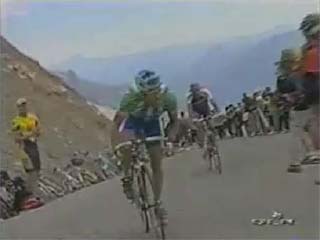
Found while cleaning my computer, above is a short movie I made a long time ago showing me on TV at the 2002 Tour de France. I'm near the top of the Col du Galibier, which is one of the highest passes in Europe and is used by the Tour de France nearly every year. In the above still image I'm on the left of the frame in a Cal Cycling kit with my yellow Cal hat on. You can hear me yelling "¡venga! ¡venga!" as Santiago Botero (who is Columbian) sprints by for maximum mountain points. Here are three different views showing how I looked that day.
more ...Collegiate Nationals Photos
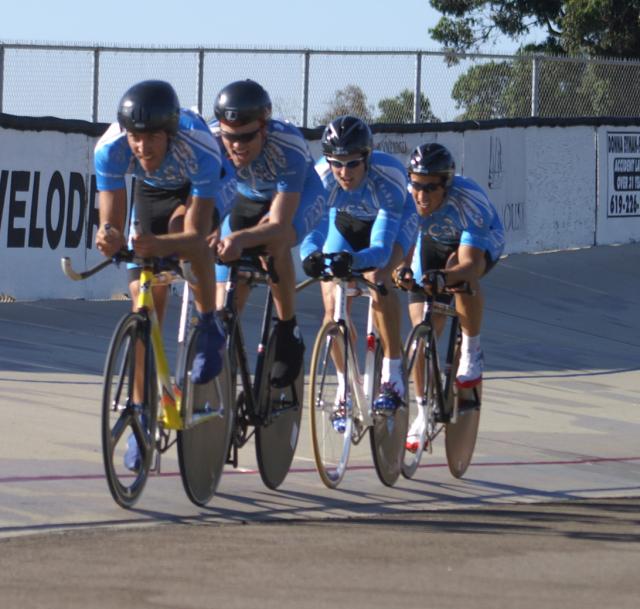
Above is a photo of Tyler Ofstad, Me, Chris Nekarda and Alex Jarman in the 4000M Men's Team Time Trial. I've posted more photos from my camera on the UCSD Cycling website. Update: The website is now very different and those photos are no longer there.
2007 Collegiate Track Nationals Video
Above is a video I put together documenting the 2007 Collegiate Track Nationals. I put this race together over the last 10 months (along with a great deal of help from others, especially Chris Nekarda). Held at the San Diego Velodrome, over 100 collegiate cyclists from around the country competed over three days. My team, UCSD, did quite well, and at least one UCSD rider was on every podium.
Some notes: If I had planned my video a bit more before the event, I could have had done a better job (imagine that!). In particular, a few of my teammates are under-represented in the video, which was purely accidental. I would have liked to have a more even coverage of everyone.
More notes: I would have uploaded the video to YouTube, but there are too many copyrighted songs that would be blocked.
I hope you enjoy the movie. Thanks to Chris Schroeder for letting me borrow his DV video camera, and Chris Nekarda for a few still photographs in the movie.
more ...Looking Fast
As you can see above, my bike looks fast! I just hope that looking fast will make me fast.
I finally have my Pro-Lite wheels on my track bike. The rear wheel has an interchangeable hub for road and track setups. It came with the road hub installed, and it was supposed to have come with the track hub part in the box. It didn't. It also didn't come with the front wheel skewer, and brake pads, which it should have. I am borrowing the missing parts for the the next week so I can actually ride my wheels.
Speaking of nice bike stuff, take a look at Anna Lang's new ride below. Her sponsors are having her ride a $9,000 Look 496 Track Frame, which is just plain crazy. She's a graduate student like me, so that's a large portion of her yearly income. There's no way she would be riding it on her own means. Here's an article about this unique frame.
more ...Leader Track Bike
Yesterday I got the replacement frame for my Broken Fuji track frame. I got an aluminum LD 735TR 61cm track frame and carbon fork for a very reasonable price, especially considering how short notice it was. I have several friends who are riding Leader frames and they are happy with them. Happily, this new bike has considerably less red than the Fuji.
If you look at the full size image (by clicking on the image above), you'll see that I've placed a piece of an old tube around the top tube using two green zip ties. This is there to protect the top tube from the handlebars, which tend to whack the top tube. Regular bikes don't need this as brake and shifter cables help dampen the handlebar swinging motion.
When I put my Pro-Lite carbon disc rear and aero front wheels (which should arrive soon!) on this black frame, it will look awesome! And that's what counts.
more ...Broken Fuji
Almost a year ago, during my return trip from Indianapolis, my 2005 Fuji Track Pro was dented due to the TSA improperly re-packing my bike box after inspecting it. I managed to parlay this into an almost $1000 check from the TSA after documenting their liability quite thoroughly.
The bike wasn't actually fatally damaged. It still rode true and there weren't any cracks, just a dent. Aluminum tubes are strong enough to use as long as they aren't creased with sharp edges (this is what I have been told). For the last five months I've been riding my Fuji with a dent in the downtube with no problems -- until now. Now, I'm afraid, the bike has made it's last lap of a velodrome. Yesterday I found that the dent has turned into a crack that you can see. The crack starts in the dent and works around the bottom of the tube to the other side.
In my Fuji's lifetime it has seen four velodromes: San Diego, Hellyer in San Jose, Northbrook in Chicago and Major Taylor in Indianapolis. My cyclometer has 2850 km on it, which works out to 1770 mi. Most of my time has been in San Diego, which is a 333 meter track. Major Taylor is also 333m, while Hellyer and and Northbrook are slightly longer. I'll simply use a 333 meter lap. That odometer distance gives 6800 laps. I'm sure the actual number is quite different than that, but you get the idea. 6800 laps is a bunch of going fast, and turning left. And not forgetting to pedal.
Goodbye good friend!
Now I need to find a new frame, soon. Hopefully the new one won't have any red on it, my one dislike of the Fuji. When that's all sorted out I'll post a picture of my new single speed steed.
more ...Madison Madness
I've been riding bikes for so long that it's unusual that I learn something new. The last couple weeks I've started learning how to do the madison, easily the most insane event on the track. The madison, named after the arena in New York City, is a team event with two riders per team. One rider is racing, while one rests. In the multi-day race events, often one rider will ride for hours, and then switch off to the other teammate.

In shorter events, both riders are on the velodrome at once. The one who is resting either rides very slowly or holds onto the railing. When the racing team member wishes to be relieved, usually after a lap or two, the resting rider meets the racer, and they exchange momentum via a hand-sling.
The thing that makes this event so darned exciting is the sheer number of things going on at once. Firstly, of course, there's a race going on. Then, you've got riders coming in & out of the event. Sometimes multiple riders are coming into the race at the same time, so positioning and timing is very important. Since it is a race where you're only going one or two laps, essentially a racer goes nearly all out, followed by a short rest.
more ...Bike RV
Here are some photos of a "Bike RV" that my father took in Northern California a few days ago. Notice in the middle photograph that there are at least three derailleurs! Here's what my father wrote:
Found parked alongside US101 on the way to Eureka. He lives in it, has pedalled it all around the US, has been doing this for years. The vehicle weighs 600 lbs or so. The panel above the seat is just a sun/rain shade, not a solar panel. The mechanical details were nicely done but I think the aerodynamics could be improved. On the other hand it's geared low and likely never goes very fast. Small bike wheel in front, fat rubber-tired go-kart wheel in back. I didn't look to see what kind of brakes. All in all it's pretty amazing that the guy could live in and pedal the thing around. I talked to him a bit, and as you might guess he seemed mildly unhinged.
My question is how does he get the thing started? Getting 600 pounds moving is no small task. And going uphill? He appears to have at least three levels of down-gearing. How does he go fast enough to not fall over? Maybe he has to spin the pedals at 120 RPM to even go anywhere. I also don't think the sun/rain shade could be that effective. To me, if I wanted to protect myself against the elements, I would get some kind of acryllic shell to go over the rider's position. It would also be much more aero.
Maybe I'm just more sane that this guy, but if I were to do this sort of thing, I'd get a bike trailer to load all my stuff behind a normal bike. Then I could ride a normal unhindered bike if I wished, leaving the trailer at the campsite. I'd have to sleep in a tent, but that's okay.
more ...Cal Poly Pomona
Epic: Surpassing the usual or ordinary, particularly in scope or size; Heroic and impressive in quality.
From Dictonary.com.
It's amazing this drug called cycling. The forecast for this weekend foretold homeric conditions -- wind, rain, and even snow or hail. I knew what was in store for me, and I raced anyway. But now, I can brag that I raced up a hill as fast as I could go, in the frickin' snow! Can you say that? That's right, you can't. Well maybe you can, but probably not.
There's not much to say about a ~15 minute effort up a hill except that if I did the climb again, I could do it at least thirty seconds faster. I did scout the climb in the car before the race, but the finish line was moved about 1/2 mile farther up the road, so I had no idea quite where to do a "finishing effort." I'm not saying I wasn't hurting, but I could have hurt more, especially more intelligently. At this moment I'm not sure of my finishing order, I think it was sixth or seventh.
What I'll remember about this race was the fact that the weather was terrible. It rained on us while we were preparing & warming up. We luckily had a pop-up tent that covered us, but not completely. The wind was strong enough for the rain to come in the sides at times. Going up the hill, only a few minutes into my race it started snowing. And I mean for real snowing, something this city-boy from coastal California doesn't often see. The visibility went down to roughly 100 feet. Luckily for my traction the snow wasn't sticking to the ground, but for most the climb there was snow from overnight storms on the trees and hillsides.
Right about when I crossed the finish line, the snow stopped falling and the view was incredible. The climb raised us over 300 meters above the valley floor, so there was quite a view. Even though I was rapidly getting cold, I pedaled up the road a bit farther just to see what there was to see. If it wasn't two hours away across the expanse of L.A. suburbs, I would like to climb this road again, but perhaps when it's a bit warmer.
Zapp Brannigan: Kif, I have the captain's itch.
Kif: I'll get the powder sir.
Zapp Brannigan: No, the itch for adventure!
Before the parking lot crit on Sunday, Chris Nekarda and I rode through the Cal Poly Pomona campus to open our legs up a bit and discuss the tatics for the race. We decided that Chris would go for all the primes except the first one, while I would see what I could do if people were feeling frisky.
From the gun a UCSB rider took off and his two teammates were in the front blocking. After a couple laps I bridged up to the UCSB rider and we worked well together, holding off the peloton. As the first prime came, Steve Sperling from UCSC went for the third place prime points and manged to get away from the pack, and bridged up to us. For the next fifteen laps or so, we traded off pulling, but it was clear that the UCSB rider was suffering more than Steve or I. Mainly through a series of hard pulls Steve and I dropped the UCSB rider.
In the closing laps we could see we were close to lapping the field, which is something I've always wanted to do (I'm sure Steve wanted to do it too). With four laps to go I took the sketchy turn a bit too hot and slipped onto my left side. I wasn't hurt badly, and I could have jumped right up and rejoined Steve, but I dropped my chain and that took some precious seconds to fix. By the time I got my chain fixed and was rolling again, I was in third place as the UCSB rider had passed me. However, he was hurting more than me and over the next four laps I caught him and passed him. I didn't even have to attack him to keep him off my wheel as I went by him.
Second place isn't as nice as first place, of course, but I'll take it. It was cool to attack the field and have some genuine race tatics happen behind us, as all of our teammates blocked for us. It wasn't so cool to crash myself out, losing the possibility at first place. It was cool to get back up again, catch and pass the UCSB rider to reclaim the second spot I had earned before my crash.
more ...